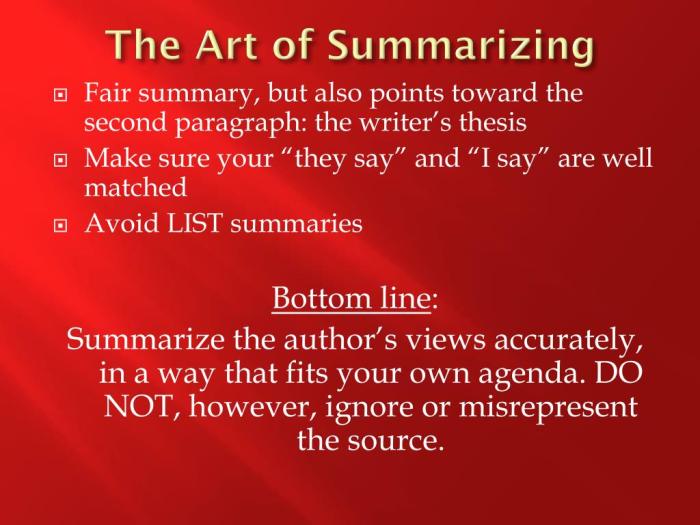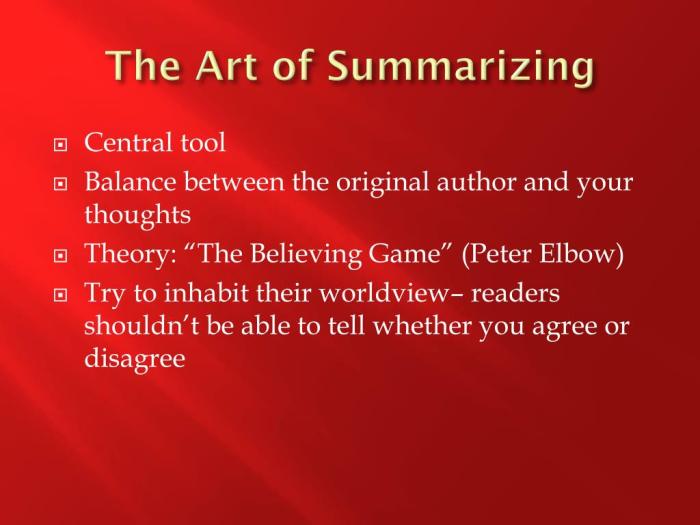The art of summarizing they say i say summary is a powerful tool that can help you to quickly and effectively understand the main points of a text. By following a few simple steps, you can learn to write summaries that are both accurate and engaging.
In this article, we will discuss the key principles of effective summarizing, as well as provide a step-by-step guide to using the “They Say, I Say” method for summarizing. We will also share some tips for using HTML tables and blockquotes in summaries, and provide examples of well-written summaries.
Introduction to Summarizing

Summarizing is a critical skill in academic writing and beyond. It allows us to condense large amounts of information into a concise and coherent form, making it easier to understand and retain key points.
Summarizing serves various purposes. It can help us:
- Preview or review material
- Identify main ideas
- Support arguments
- Communicate complex information effectively
Examples of summarizing include:
- Creating a summary of a research article for a literature review
- Summarizing a chapter in a textbook for a study guide
- Providing a brief overview of a presentation or lecture
The Art of Summarizing

Effective summarizing involves adhering to key principles:
- Accuracy:The summary should faithfully represent the original text.
- Conciseness:The summary should be significantly shorter than the original text.
- Objectivity:The summary should avoid bias and personal opinions.
- Coherence:The summary should flow logically and make sense as a standalone piece.
Techniques for summarizing include:
- Extraction:Identifying and extracting key sentences or phrases from the original text.
- Paraphrasing:Restating key ideas in your own words.
- Generalization:Summarizing multiple ideas or details into a broader concept.
- Integration:Combining information from different sources into a cohesive summary.
Examples of well-written summaries:
- A summary of a scientific study that concisely presents the research question, methods, results, and conclusions.
- A summary of a historical event that highlights the key actors, causes, and consequences.
- A summary of a literary work that provides an overview of the plot, characters, and themes.
They Say, I Say: A Method for Summarizing
The “They Say, I Say” method is a structured approach to summarizing that helps writers:
- Acknowledge and engage with the ideas of others
- Clearly state their own perspectives
- Avoid plagiarism
Step-by-step guide to using the method:
- Introduce the topic and the author’s perspective:“According to [author’s name], [author’s perspective].”
- Summarize the author’s main points:“They argue that [author’s main points].”
- State your own perspective:“I agree/disagree with this perspective because [your reasons].”
- Provide evidence to support your perspective:“For example, [evidence].”
Benefits of the method:
- Helps writers avoid plagiarism by clearly attributing ideas to their sources.
- Encourages writers to engage with the ideas of others and develop their own perspectives.
- Provides a structured framework for writing summaries.
Limitations of the method:
- Can be time-consuming to apply.
- May not be suitable for all types of summarizing tasks.
Summarizing in Practice
Example of a summary using the “They Say, I Say” method:
Topic:The benefits of mindfulness
Summary:
According to Jon Kabat-Zinn, mindfulness is a practice that can reduce stress and improve well-being. He argues that mindfulness allows individuals to focus on the present moment and accept their thoughts and feelings without judgment. I agree with this perspective because research has shown that mindfulness can help individuals reduce anxiety, improve sleep, and enhance emotional regulation.
Analysis:
This summary effectively summarizes Kabat-Zinn’s perspective on mindfulness and provides evidence to support the writer’s agreement with his views. The summary is concise, accurate, and objective.
Strategies for improving summarizing skills:
- Practice regularly.
- Use different summarizing techniques.
- Get feedback from others.
- Use summarizing tools and resources.
Using HTML Tables in Summaries
HTML tables can be used to present summaries in a structured and visually appealing manner.
Example of an HTML table:
| Author | Perspective | Evidence |
|---|---|---|
| Jon Kabat-Zinn | Mindfulness reduces stress | Research has shown that mindfulness can help individuals reduce anxiety and improve sleep. |
| Thich Nhat Hanh | Mindfulness promotes compassion | Mindfulness helps individuals develop empathy and understanding for others. |
Benefits of using HTML tables:
- Improves readability and organization.
- Makes it easy to compare and contrast different perspectives.
- Can be used to highlight important information.
Using Blockquotes in Summaries
Blockquotes can be used to highlight important quotes or ideas in a summary.
Example of using a blockquote:
Mindfulness is the ability to be fully present, aware of where we are and what we’re doing, and not overly reactive or overwhelmed by what’s going on around us.
– Jon Kabat-Zinn
Benefits of using blockquotes:
- Draws attention to important ideas.
- Adds credibility to the summary by citing sources.
- Can be used to break up the text and make it more visually appealing.
Illustrating Summaries
Visual illustrations can be used to enhance summaries and make them more engaging.
Types of illustrations:
- Charts
- Graphs
- Diagrams
- Images
Benefits of using illustrations:
- Clarifies complex concepts.
- Makes summaries more memorable.
- Appeals to different learning styles.
Tips for creating effective illustrations:
- Choose illustrations that are relevant to the topic.
- Make sure illustrations are clear and easy to understand.
- Use a consistent style throughout the summary.
Advanced Summarizing Techniques: The Art Of Summarizing They Say I Say Summary

Advanced summarizing techniques can enhance the accuracy and efficiency of the summarizing process.
Using AI tools for summarizing:
- AI tools can automate the summarizing process.
- AI-generated summaries can be used as a starting point for human-written summaries.
- Benefits of using AI tools:
- Saves time
- Improves accuracy
- Provides consistent results
- Challenges of using AI tools:
- AI-generated summaries may not be as nuanced as human-written summaries.
- AI tools may introduce bias into the summarizing process.
Question & Answer Hub
What is the purpose of a summary?
A summary is a brief overview of a text that captures the main points and key ideas.
What are the different types of summaries?
There are two main types of summaries: descriptive summaries and analytical summaries.
What is the “They Say, I Say” method for summarizing?
The “They Say, I Say” method is a step-by-step guide to writing summaries that are both accurate and engaging.